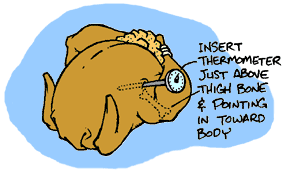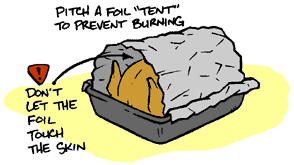Roast A Turkey
If you're using an oven-safe meat thermometer, place it just above the thighbone and point it toward the body. The thighbone is relatively centered in the thigh. The thermometer should not touch the bone, but should go deep into the thigh meat. Turn the thermometer so you can read the dial while the turkey is roasting.

If you're using an instant-read thermometer, it won't be safe in the oven while the turkey is roasting, but you can use it in the later stages of roasting to find out how done the turkey is. When using it, position it in the same place you would an oven-safe thermometer.
Place your turkey into the preheated oven. You can relax a little now. But every 30 minutes or so, you should baste the turkey. The purpose of basting is to keep the turkey meat moist.
Baste your turkey by covering it in its own juice. If you have a basting syringe, use it to draw up the drippings in the pan and then gently spray them over the top of the turkey. If you're using a basting brush, dip it into the juices and gently brush it over the turkey.
If the turkey hasn't produced much juice early in the roasting process, you can baste the turkey with melted butter.
About two-thirds through the roasting time, once the skin turns golden brown, place an aluminum foil tent over the turkey to protect it from burning. Make sure you prop the foil tent on the sides of the pan or rack, so it doesn't touch the skin.
The best way to determine if a turkey is done is to test it with a thermometer. Partially cooked poultry is unhealthy to serve, due to the bacteria that may have survived in it.
Begin to test for doneness 30 minutes before you expect the turkey to be ready. There are three readings you can take with your meat thermometer to make sure the turkey is fully cooked.
Thigh: The temperature deep inside the thigh should be 180° to 185°F (82° to 85°C). Don't hit the bone with the thermometer when taking this reading.
Breast: The temperature in the thickest part of the breast should be 170° to 175°F (77° to 79°C). Measure just above the ribs, and again don't touch the thermometer to the bone.
Stuffing: If you stuffed the turkey, check it for doneness. A thermometer placed in the center of the stuffing should read at least 165°F (74°C).
If you don't have a thermometer, you can visually check the turkey and rely on the timing schedule based on the turkey's weight. When you check the turkey, pierce the thigh deeply to check the juice coming from the meat. The juice should be clear and not pink.
When you determine that your turkey is done, take it out of the oven and let it cool for 20 minutes. That will allow it to soak up all its juices, and will make it easier to carve. Save the juices in the pan for making gravy. When the turkey has cooled, remove the stuffing, and place the turkey on a serving platter.
Letting the turkey sit before carving it also piques your guests' appetites. More important, it allows time for everyone to praise you for what a beautiful roast turkey you've created. To make gravy, use this ratio of ingredients: one tablespoon of flour per one tablespoon of fat per one cup of liquid. Then follow these guidelines:
If you decide to use cornstarch instead of flour as the thickening agent, use 1/2 tablespoon of cornstarch per tablespoon of fat. Heat half the liquid and all the fat you plan to use in the pan, but add the cornstarch to the remaining, cooler liquid. Stir it in until smooth. Then slowly add the combined cornstarch and liquid to the pan, stirring as you go.

Determine if the turkey is done
Make some gravy (optional)
Roast a Turkey Part 1 .
The information and graphics on this webpage provided by the old http://tutorials.learn.com/custom/linkshare/linkshare.asp 
![]()
![]()
![]()